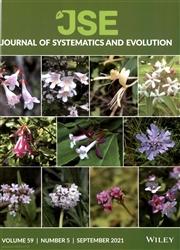黍形目/稗形目支系(豆科:木犀草属)的分子系统发育和时空分化
IF 3.7
1区 生物学
Q1 Agricultural and Biological Sciences
引用次数: 0
摘要
Millettioid/Phaseoloid(或 Millettioid)支系是木犀草亚科(豆科)的一个主要支系,但人们对该支系的多样性和生物地理历史知之甚少。为了填补这一空白,我们利用 nrDNA ITS、质体 matK 和质体序列(包括 38 个新测序的质体),为代表该支系约 80% 属的 749 个物种建立了时间校正的系统发生。利用这一系统发育框架,我们探索了该支系的时间分化,并重建了其祖先地区和扩散事件。我们的系统发育分析支持小米科/相思鸟科及其四个支系(Abreae、Desmodieae、Indigofereae 和 Psoraleeae)的单系性,而两个支系(sensu lato millettioids 和 phaseoloids)的多系性。化石校准年代分析表明,在古新世,黍形目/相叶目支系的茎节(约 62 Ma)和冠节(约 61 Ma)几乎同时分化。生物地理学分析表明,该支系起源于非洲,并在新生代的不同时期扩散到亚洲、欧洲、澳大利亚和美洲。我们发现有证据表明,在整个新生代,黍形目/蝶形目支系的分化率发生了变化,自约 10 Ma 以来,净分化率迅速上升。黍形目/瓣鳃目支系现今物种丰富度和分布的可能解释包括北热带迁徙、整个新生代频繁的洲内和洲际远距离扩散以及中新世气候最适宜期之后物种分化率的升高。总之,这些结果为了解黍属/豌豆属支系的主要分化模式提供了新的视角,为今后对这一重要豆科支系的进化研究奠定了基础。本文章由计算机程序翻译,如有差异,请以英文原文为准。
Molecular phylogeny and spatio‐temporal diversification of the Millettioid/Phaseoloid clade (Fabaceae: Papilionoideae)
The Millettioid/Phaseoloid (or the Millettioid) clade is a major lineage of the subfamily Papilionoideae (Fabaceae) that is poorly understood in terms of its diversification and biogeographic history. To fill this gap, we generated a time‐calibrated phylogeny for 749 species representing c. 80% of the genera of this clade using nrDNA ITS, plastid matK, and plastome sequence (including 38 newly sequenced plastomes). Using this phylogenetic framework, we explored the clade's temporal diversification and reconstructed its ancestral areas and dispersal events. Our phylogenetic analyses support the monophyly of the Millettioid/Phaseoloid clade and four of its tribal lineages (Abreae, Desmodieae, Indigofereae, and Psoraleeae), while two tribal lineages sensu lato millettioids and phaseoloids are polyphyletic. The fossil‐calibrated dating analysis showed a nearly simultaneous divergence between the stem node (c. 62 Ma) and the crown node (c. 61 Ma) of the Millettioid/Phaseoloid clade in the Paleocene. The biogeographic analysis suggested that the clade originated in Africa and dispersed to Asia, Europe, Australia, and the Americas at different periods in the Cenozoic. We found evidence for shifts in diversification rates across the phylogeny of the Millettioid/Phaseoloid clade throughout the Cenozoic, with a rapid increase in net diversification rates since c. 10 Ma. Possible explanations for the present‐day species richness and distribution of the Millettioid/Phaseoloid clade include boreotropical migration, frequent intra‐ and intercontinental long‐distance dispersals throughout the Cenozoic, and elevated speciation rates following the Mid‐Miocene Climatic Optimum. Together, these results provide novel insights into major diversification patterns of the Millettioid/Phaseoloid clade, setting the stage for future evolutionary research on this important legume clade.
求助全文
通过发布文献求助,成功后即可免费获取论文全文。
去求助
来源期刊

Journal of Systematics and Evolution
Agricultural and Biological Sciences-Ecology, Evolution, Behavior and Systematics
CiteScore
7.40
自引率
8.10%
发文量
1368
审稿时长
6-12 weeks
期刊介绍:
Journal of Systematics and Evolution (JSE, since 2008; formerly Acta Phytotaxonomica Sinica) is a plant-based international journal newly dedicated to the description and understanding of the biological diversity. It covers: description of new taxa, monographic revision, phylogenetics, molecular evolution and genome evolution, evolutionary developmental biology, evolutionary ecology, population biology, conservation biology, biogeography, paleobiology, evolutionary theories, and related subjects.
 求助内容:
求助内容: 应助结果提醒方式:
应助结果提醒方式:


